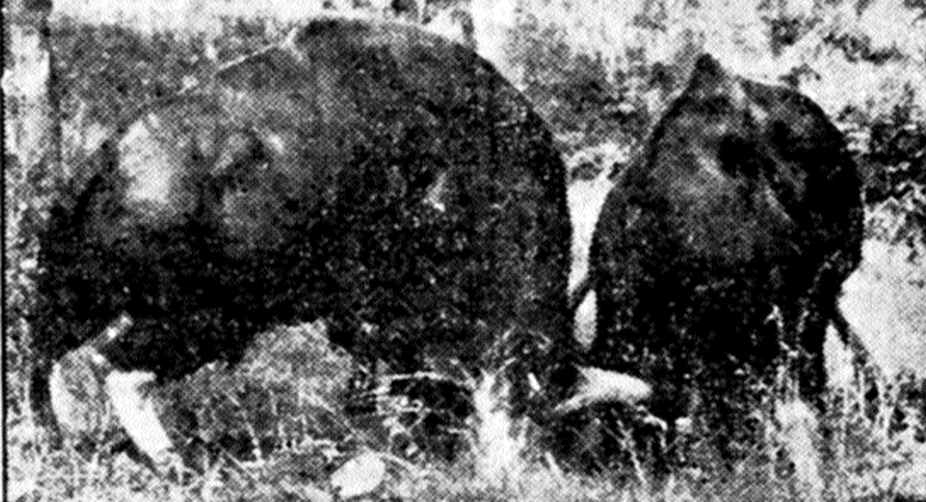There were three others with me on the pad of the riding elephant when all this happened, three independent witnesses.
Gaur in the Mudumalai Sanctuary tends to congregate in the Theppakkadu area in Sept-ember. The ground vegetation here consists mainly of short grass, herbs and creepers, while elsewhere in the sanctuary, tall grass chokes up the jungles. Theppakkadu is remarkable for its extensive forest of natural teak, growing in open formations where visibility is good, but patches of close-growing Anogeissus provide denser cover to the animals in places. There are perennial sources of water, and the fast-flowing Moyar river, separating Mysore from Madras, borders these jungles. And here, in September-October, large composite herbs of gaur, and smaller herds, are often to be found.
That day I was trying for a portrait in profile of a big herd-bull with a Roman nose and a decided dewlap that I had seen here earlier; despite what the books (which the illiterate beasts have not read) say, many full-grown and even old gaur bulls do not have Roman noses. Well, we had no luck with that bull. We found him, but he entered one of the few patches of tall grass there, lay down, and refused to budge, and I had to postpone the attempt to another day (when I did get the portrait I wanted). We then scouted idly around, hoping, unreasonably, to see a more obliging bull with a Roman nose. And within half a mile we saw two bulls, adult, massive and black, grazing in the open jungles together.
They did not have Roman noses, but still they interested me. I thought they were lone bulls going about in a pair, as others have said lone bulls do at times. I had never seen such a pair before, though I have seen the bulls of a composite herd grazing together, apart from the herd, and I was keen on getting closer to this pair to observe it. This was easier than it could have been, because, by reaching a point ahead of them, we had the animals grazing towards our halted elephant, some ten yards apart from each other Gradually they converged till they were only a few feet apart, continuing to graze unhurriedly and unmindful of us; they were now so close that the depth of field was limited and I could get only the nearer (and slightly larger) bull in sharp focus
They faced each other, glaring, and suddenly pitched into each other fighting furiously with lowered heads and locked horns, forefeet braced, tails tightly depressed into the groove between the haunches (the tail is waved aloft in a triumphant flag only in pictures of fighting gaur). Each heaving with his ton of bone and muscle to push his rival away. Obviously these were herd-bulls, fighting for territory.
You know how it always is, I had just finished the last frame in my camera, and by the time I could reload, the bulls, circling around the pivot of their heads, had moved farther away, behind an obscuring bush — however, I got one picture, showing their heaving action.
The noise of the resounding, clashing horns was quite as impressive as the sight of the battle. Peremptorily as they had started the fight, the bulls broke away, and began to graze again, but within seconds they were re-engaged in combat, I could watch the violent action but not photograph it, because of intervening trees and bushes — they were now almost 30 yards away.
A sound like the sigh and patter of an approaching rainstorm came towards us through the jungle, and before our astonished eyes a whole herd of gaur came galloping up. In the van was a young, full-grown bull, a trifle smaller than the combatants and with a touch of dark umber on his blackening coat still — I have often noticed such a second-in-command in a large, composite herd. Whereas the fighting bulls made no noise beyond the clash of their horns, and indulged in no brave flourishes, the newcomer went berserk ostentatiously, in a demonstration of power and protest. With loud, angry, moaning sounds (singularly expressive of disapproval to human ears) he dashed right between the fighters, who had separated at his approach, and tore up the bushes with his still-sharp horns. None of the cows followed him — they stood in a solid, watchful ring, to one side of us — but three very young calves, a golden brown and with their upraised tails waving in the air, galloped gaily in the wake of the peacemaker, between the late combatants!
After a few seconds, the demonstrating bull went up to one of the two combatants (the one that was slightly bigger) and stood close by, actually nuzzling him. The other bull turned his back on this sentimental display of loyalty and grazed steadily away from the herd and from us. Then the entire herd, with their reclaimed overlord moved into the jungle past us; we followed them for some time and then left them in peace.
So far as I know, such an attempt by the herd to intervene in a fight has not been recorded before, but I have reasons for thinking that it is less uncommon than might be imagined. Of course gaur bulls do fight much more conclusively for territory and herds, but sometimes. I believe they are prevented from continuing a fight begun. Realising the importance of getting a record of what was happening, I hastily exchanged by narrow-visioned Ponderosa for a snapshot camera and took a series of photographs. Later I found that in the rough and tumble of elephant-back travel through the tree jungles, the front cell of the lens had been loosened, with the result that all the pictures are out of focus, but still they have record value.
This was published on February 23 1964 in the Sunday Statesman.
